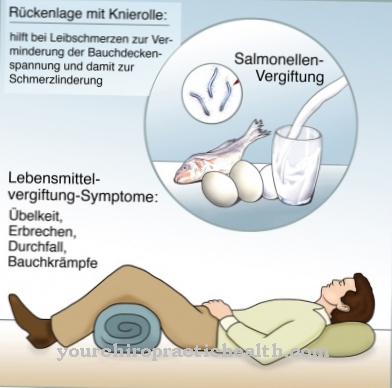As Scaphoid fracture is called a fracture of a carpal bone. The scaphoid bone is the most vulnerable bone in the area of the carpal bones and is also known as the scaphoid bone. In rare cases, a scaphoid fracture can also occur in the foot, as there is also a scaphoid bone in the tarsus there.
What is a scaphoid fracture?

Of the Scaphoid fracture is a fracture in the area of the carpal bones. The navicular bone is located between the radius and the first metacarpal and connects the wrist with the metacarpal. It lies on the side of the thumb and is in the first row of carpal roots.
A scaphoid fracture is most common in the carpal bones. A scaphoid fracture is relatively difficult to diagnose. Furthermore, so-called pseudoarthroses, a malfunction of the bone healing, often occur.
Both the wrist and the ankle have a navicular bone in the root bone. Because of this, a fracture of the scaphoid bone can also mean a fracture of the tarsal bones. However, this type of fracture is extremely rare. A scaphoid fracture usually takes up to 12 or more weeks to heal.
causes
The most common cause of one Scaphoid fracture is an accident. The fracture usually occurs as a result of a fall that you try to catch with your hands. One usually falls on the outstretched hand, which is bent backwards on impact.
The navicular bone is pinched between the spoke and the other carpal bones. The scaphoid bone breaks when the force is applied. A scaphoid fracture often occurs as part of a car accident. In the event of a collision, you support yourself with your hands on the steering wheel. The affected person often breaks the scaphoid bone.
Symptoms, ailments & signs
If a scaphoid bone fracture occurs, severe pain occurs immediately in the wrist area. The symptoms mainly occur near the thumb and increase when the hand and fingers are moved. The fracture is associated with a swelling or a bruise, with external injuries skin damage and bleeding occur.
The mentioned scaphoid fracture symptoms are mostly unspecific and can also have other causes. A clear sign is the severe pain that occurs when pressure is applied to the wrist. If the joint is touched at the point of the fracture, an acute stinging occurs, which can radiate into the hand and into the forearm. If there is no treatment, the pain can become so severe that it can lead to nausea and circulatory problems.
The movement restrictions are also a clear indication of a break. The hand can normally no longer be moved or only to a limited extent, which results in a relieving posture. In particular, the grip movement of the hand is considerably restricted. In some cases there are disorders of sensitivity and symptoms of paralysis. If nerves have been injured, the affected hand can be completely paralyzed.
Diagnosis & course
The diagnosis is made Scaphoid fracture by an orthopedic surgeon. However, diagnosis can often be difficult. At the beginning, the injured hand is examined for external injuries. This is followed by a test of mobility. The hand is also felt to determine whether movement or pressure is causing pain. In addition, it will be clarified whether there is a sensitivity disorder.
After the visual and tactile examination, x-rays are made in four planes, although these do not always reliably represent a scaphoid fracture. Because of this, a computer tomography is usually also made. This also gives an indication of which treatment method (conservative or surgical) is best suited.
The course of a scaphoid fracture depends on several factors. With a stable fracture and adequate treatment, the scaphoid fracture heals i. d. R. without consequences. The healing phase can take up to 12 weeks or more. Complications often occur - especially in the case of scaphoid fractures that are not discovered or discovered too late - in the form of pseudoarthroses.
Here the bone heals together incorrectly or only poorly. Due to circulatory disorders, healing can also be delayed. A fracture of the scaphoid bone can result in permanent restriction of movement as well as chronic pain.
Complications
As a rule, the scaphoid fracture can occur either on the hand or on the foot. In both cases, there are limitations and pain in the patient's everyday life, so that the quality of life is significantly reduced by this symptom. Most patients also have swelling in the affected areas.
If the scaphoid fracture occurs in the hand, the patient can no longer grasp and take it. The hand's sensitivity can also be disturbed by the fracture, causing paralysis or tingling. Complications can arise if the scaphoid fracture is not treated. This can lead to irreversible restrictions on movement.
Diagnosing a scaphoid fracture is relatively simple and can be done quickly. This means that treatment can also be initiated at an early stage. There are no particular complications in the treatment itself. If necessary, a disturbance of the blood circulation can occur in the affected area.
This disorder also needs treatment. The life expectancy of the patient is not changed by this break. With the help of a plaster cast, the symptoms disappear after a few weeks and the patient can usually use the hand or foot again.
When should you go to the doctor?
A doctor should be consulted after a serious accident. If the scaphoid bone is injured in a fall or accident, a doctor must be consulted in any case. Warning signs such as swelling or externally visible bruises must be clarified in each case. Bleeding or even an open hernia also require immediate diagnosis and treatment by a specialist. This is especially true if the injury restricts movement or causes other complications.
If paralysis or sensitivity disorders become noticeable in the affected body part, a doctor must be consulted. A scaphoid fracture usually heals quickly and without complications if treated early. Nevertheless, consultation with the doctor should be maintained during recovery. If you experience pain while healing, or if you feel that the bone is not growing together properly, you should see a doctor. The right contact person is the family doctor or an internist. Seriously injured people have to be treated in a hospital.
Treatment & Therapy
When treating a Scaphoid fracture As an immediate measure, raising the hand, cooling with cool packs and protecting the hand are recommended.
With the help of computed tomography you can see how and where the scaphoid bone is broken. On the basis of this, a decision is then made as to whether conservative treatment should be used or whether a surgical procedure is necessary.
If the scaphoid bone fracture is stable, a plaster of paris or plastic bandage is applied after the swelling has declined and must be worn for up to 12 weeks. Usually the hand, thumb and forearm are in a cast. If the bone parts are displaced in a scaphoid bone fracture, i. d. Usually surgery is required. The navicular bone is fixed with several screws.
During the healing phase, regular x-rays must be taken for control purposes. These are used to monitor the healing process. It is also checked whether there is a circulatory disorder. The treatment of a scaphoid fracture can take a long time and, under unfavorable circumstances, result in consequential damage. After the plaster cast has been removed, physiotherapeutic measures are recommended in the event of a scaphoid fracture. If there is a scaphoid fracture in the tarsal area, the same treatment methods are usually used.
Outlook & forecast
If the scaphoid fracture is on the foot bone, absolute protection must be observed throughout the entire healing process. If the scaphoid fracture of the hand is immobilized by a cast, light activities can be started again after about a month.
Since muscles atrophy and tendons shorten during prolonged rest periods, regular physiotherapy must be started after approval by the doctor. In order to achieve visible results quickly, this must be supplemented at home with gentle exercises from the field of physiotherapy and occupational therapy. However, the therapist's instructions must always be observed here, as excessive stress could lead to a renewed fracture. As a rough guideline, intensive exercise should only take place after about six months. A regular x-ray check provides information about the resilience.
If the fracture was straightened without immobilizing the plaster, but instead by means of a small outpatient attack by inserting a cannulated screw, it can heal more quickly and thus enables a faster load-bearing capacity.
In order to alleviate the sometimes very severe pain, those affected can use natural remedies in addition to the prescribed, prescription drugs. Some preparations can be used internally as tea, drops or tablets, but also as a cream to apply directly to the painful area.
prevention
There are no preventive measures to one Scaphoid fracture to prevent. One can only take general precautionary measures such as B. Mindfulness in traffic, walking only on level ground, avoiding high-risk sports in which falls are inevitable.
Aftercare
Follow-up care for a scaphoid fracture consists of several steps. First, the wrist is immobilized. The duration of the immobilization can last from one to two days to six weeks, depending on the type of fracture. In the case of fractures that are more difficult to heal, immobilization can last longer. This is assessed and decided in each individual case by the operating doctor.
The sutures on the scar are removed approximately 12 to 14 days after the procedure. There are typically three to seven threads that need to be removed. The immobilization is carried out using a forearm plaster splint. Except for the thumb joint, the plaster splint immobilizes the wrist and the remaining thumb joints.
Even with non-invasive treatment, the plaster splint is used at the beginning. The cast can be changed two to three times a week for the first few weeks to inspect the wound. Once the sutures have been removed, the wrist is immobilized by a removable wrist splint. As soon as the splint is removed, full load should be avoided.
The hand that has been operated on has to be continuously accustomed to normal stress again. The attending physician can use X-rays to say most precisely when full exercise is possible again. Sports activities should be avoided for another three to four months.
You can do that yourself
After a scaphoid fracture, the affected person must first take it easy. The person concerned should take sick leave for at least five to six weeks. Office work can usually be resumed after three to four weeks.
Since the muscles atrophy after the long period of rest and the tendons are mostly shortened, consequent physiotherapy is indicated afterwards. Outpatient mobilization measures such as physiotherapy or occupational therapy are also necessary and can be supplemented with gentle exercises at home. The doctor will inform the patient about which training methods are useful and promote healing. Exhausting physical activity should be avoided in the first few weeks, as otherwise a new fracture can develop relatively quickly and recovery will be delayed.
In addition to the prescribed medication, the patient can also try various natural remedies. The pain-relieving devil's claw, for example, can be taken as a tea or applied as an ointment. After the plaster of paris has been removed, ointments and creams may be applied to the injury after consulting the doctor. If the scaphoid fracture has not healed after a few weeks, the doctor must be informed.


.jpg)
.jpg)
.jpg)






















